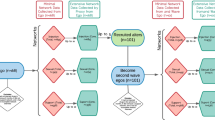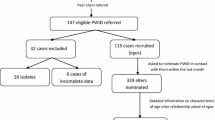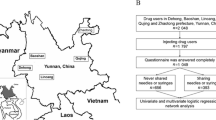Abstract
Background: There is little understanding about how the social networks of cocaine injectors are different from those of heroin users and about how such differences are associated with injection risk behaviours. Therefore, the objective of this study was to compare drug-injecting network characteristics of cocaine and heroin injectors believed to be associated with a risk of bloodborne infections.
Methods: Active injection drug users (IDUs) were recruited between April 2004 and January 2005 from three syringe exchange and two methadone treatment programs in Montreal, Canada. Characteristics of each participant and of up to 10 social network members (IDU and non-IDU) with whom frequent contact had occurred in the past month were elicited using a structured, interviewer-administered questionnaire. The current analysis focussed on the drug-injecting network members. Logistic regression was used to examine network characteristics in relation to cocaine and heroin injection.
Results: Of 282 study subjects, 81% used cocaine and 19% used heroin as their primary injected drug in the past 6 months. Compared to heroin injectors, participants who injected cocaine had lower odds of knowing their network members for a longer time (OR=0.92, 0.85–0.99), were more likely to report a larger IDU network (OR=1.64, 1.18–2.29) and have IDU partners who had a history of attending shooting galleries (OR=2.42, 1.05–5.56).
Interpretation: This study identified high-risk network-related factors associated with bloodborne infections in cocaine injectors. Prevention efforts may benefit from tailoring interventions according to type of drug used, with particular attention to the drug injecting-network of IDUs.
Résumé
Contexte: On comprend mal la différence entre les réseaux sociaux des personnes qui s’injectent de la cocaïne et ceux des utilisateurs d’héroïne et l’influence que ces différences peuvent avoir sur les comportements d’injection à risque, qui à leur tour peuvent influencer le risque d’infections transmises par le sang. La présente étude a pour objectif de recenser les caractéristiques des réseaux sociaux associées à l’injection de cocaïne et d’héroïne.
Méthodologie: Des utilisateurs de drogues injectables (UDI) actifs ont été recrutés entre avril 2004 et janvier 2005 au sein de programmes d’échange de seringues et de traitement à la méthadone à Montréal, au Canada. Les caractéristiques des participants et d’un maximum de dix membres de leur réseau social (UDI et non-UDI) avec qui les participants avaient eu des contacts fréquents au cours du mois précédent ont été recensées au moyen d’un questionnaire structuré. Cette analyse met l’accent sur les participants à l’étude qui sont des utilisateurs de drogues injectables. La régression logistique a été utilisée pour l’examen des caractéristiques des personnes et du réseau en relation avec l’injection de cocaïne et d’héroïne.
Résultats: Sur 282 UDI, 81 % avaient consommé de la cocaïne et 19 % de l’héroïne comme principale drogue injectable au cours des six mois précédents. Les analyses de régression logistiques ont permis de constater que les utilisateurs de cocaïne étaient plus susceptibles que les utilisateurs d’héroïne de connaître les membres de leur réseau depuis peu de temps (OR=0,92[0,85–0,99]), de signaler un réseau UDI plus étendu (OR=1,64[1,18–2,29]) et d’avoir des partenaires UDI qui s’étaient injecté des drogues dans une piquerie (OR=2,42[1,05–5,56]).
Interprétation: Cette étude a permis de recenser les facteurs liés au réseau et associés à un risque accru d’infection transmissible par le sang chez les utilisateurs de cocaïne, en comparaison aux utilisateurs d’héroïne. Les efforts de prévention pourraient bénéficier d’une personnalisation des interventions selon le type de drogue utilisée, en portant une attention particulière aux réseaux sociaux des UDI.
Similar content being viewed by others
References
Single E. A sociodemographic profile of drug users in Canada. Prepared for the HIV/AIDS Prevention and Community Action Programs of Health Canada. Ottawa, ON, 2000;39–40.
Morissette C, Roy E, Parent N and the SurvUDI working group. Temporal trends in HIV incidence and risk behaviours among IDUs in the SurvUDI study 1995–2002. Can J Infect Dis 2004;15(Suppl A):49A.
Chaisson RE, Bacchetti P, Osmond D, Brodie B, Sande MA, Moss AR. Cocaine use and HIV infection in intravenous drug users in San Francisco. JAMA 1989;261(4):561–65.
Anthony JC, Vlahov D, Nelson KE, Cohn S, Astemborski J, Solomon L. New evidence on intravenous cocaine use and the risk of infection with human immunodeficiency virus type 1. Am J Epidemiol 1991;134(10):1175–89.
Tyndall MW, Currie S, Spittal P, Li K, Wood E, O’Shaughnessy MV, et al. Intensive injection cocaine use as the primary risk factor in the Vancouver HIV-1 epidemic. AIDS 2003;17(6):887–93.
Latkin CA, Forman V, Knowlton A, Sherman S. Norms, social networks, and HIV-related risk behaviors among urban disadvantaged drug users. Soc Sci Med 2003;56(3):465–76.
Schroeder JR, Latkin CA, Hoover DR, Curry AD, Knowlton AR, Celentano DD. Illicit drug use in one’s social network and in one’s neighborhood predicts individual heroin and cocaine use. Ann Epidemiol 2001;11(6):389–94.
Hoffmann JP, Su SS, Pach A. Changes in network characteristics and HIV risk behavior among injection drug users. Drug Alcohol Depend 1997;46(1-2):41–51.
Suh T, Mandell W, Latkin C, Kim J. Social network characteristics and injecting HIV-risk behaviors among street injection drug users. Drug Alcohol Depend 1997;47(2):137–43.
Vlahov D, Munoz A, Anthony JC, Cohn S, Celentano DD, Nelson KE. Association of drug injection patterns with antibody to human immunodeficiency virus type 1 among intravenous drug users in Baltimore, Maryland. Am J Epidemiol 1990;132(5):847–56.
Leri F, Stewart J, Fischer B, Jurgen R, Marsh DC, Brissette S, et al. Patterns of opioid and cocaine co-use: A descriptive study in a Canadian sample of untreated opioid-dependent individuals. Exp Clin Psychopharmacol 2005;13(4):303–10.
Latkin C, Mandell W, Oziemkowska M, Celentano D, Vlahov D, Ensminger M, et al. Using social network analysis to study patterns of drug use among urban drug users at high risk for HIV/AIDS. Drug Alcohol Depend 1995;38(1):1–9.
Shelley GA, Bernard HR, Killworth P, Johnsen E, McCarty C. Who knows your HIV status? What HIV+ patients and their network members know about each other. Soc Networks 1995;17(3):189–219.
Author information
Authors and Affiliations
Corresponding author
Additional information
Acknowledgements: This paper was presented in part at the 96th Annual CPHA Conference, Ottawa, Canada. Prithwish De is supported by a Canadian Institutes of Health Research (CIHR) Doctoral Research Award and by the CIHR Transdisciplinary Research Training Initiative in Population and Public Health of Quebec.
Rights and permissions
About this article
Cite this article
De, P., Jolly, A., Cox, J. et al. Characterizing the Drug-injecting Networks of Cocaine and Heroin Injectors in Montreal. Can J Public Health 97, 207–209 (2006). https://doi.org/10.1007/BF03405586
Published:
Issue Date:
DOI: https://doi.org/10.1007/BF03405586




